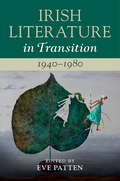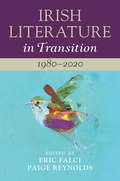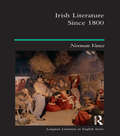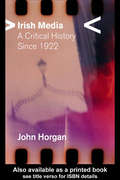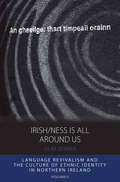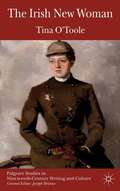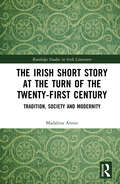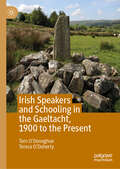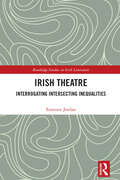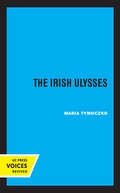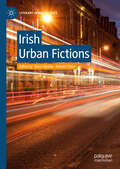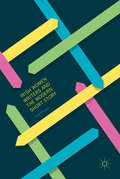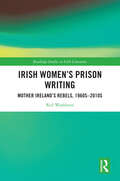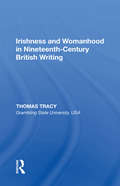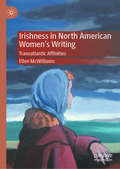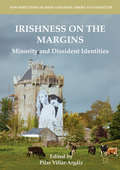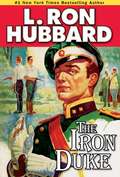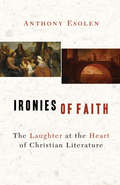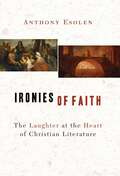- Table View
- List View
Irish Literature in Transition, 1940–1980: Volume 5 (Irish Literature in Transition)
by Eve PattenThis volume explores the history of Irish writing between the Second World War (or the 'Emergency') in 1939 and the re-emergence of violence in Northern Ireland in the 1970s. It situates modern Irish writing within the contexts of cultural transition and transnational connection, often challenging pre-existing perceptions of Irish literature in this period as stagnant and mundane. While taking into account the grip of Irish censorship and cultural nationalism during the mid-twentieth century, these essays identify an Irish literary culture stimulated by international political horizons and fully responsive to changes in publishing, readership, and education. The book combines valuable cultural surveys with focussed discussions of key literary moments, and of individual authors such as Seán O'Faoláin, Samuel Beckett, Edna O'Brien, and John McGahern.
Irish Literature in Transition: 1980–2020: Volume 6 (Irish Literature in Transition)
by Eric Falci Paige ReynoldsIrish Literature in Transition, 1980–2020 elucidates the central features of Irish literature during the twentieth century's long turn, covering its significant trends and formations, reassessing its major writers and texts, and providing path-making accounts of its emergent figures. Over the past forty years, life in the Republic of Ireland and Northern Ireland has been transformed by new material conditions in each polity and by ideological shifts in the way people understand themselves and their relation to the world. Amid these remarkable changes, culture on both sides of the border has emerged as a global phenomenon, one that both reflects and intervenes in rapidly changing contemporary conditions. This volume accounts for broad patterns of literary and cultural production in this period and demonstrates the value of Irish contemporary literature within anglophone and European traditions and as a body of work that has kept its eye trained on the particularities of the island and its inhabitants.
Irish Literature Since 1800 (Longman Literature In English Series)
by Norman VanceThis book surveys Irish writing in English over the last two centuries, from Maria Edgeworth to Seamus Heaney, to give the literary student and the general reader an up-to-date sense of its variety and vitality and to indicate some of the ways in which it has been described and discussed. It begins with a brief outline of Irish history, of Irish writing in Irish and Latin, and of writing in English before 1800. Later chapters consider Irish romanticism, Victorian Ireland, W.B.Yeats and the Irish Literary Revival, new directions in Irish writing after Joyce and the literature of contemporary Ireland, north and south, from 1960 to the present.
Irish Media: A Critical History since 1922
by John HorganIrish Media: A Critical History maps the landscape of media in Ireland from the foundation of the modern state in 1922 to the present. Covering all principal media forms, print and electronic, in the Republic and in Northern Ireland, John Horgan shows how Irish history and politics have shaped the media of Ireland and, in turn, have been shaped by them.Beginning in a country ravaged by civil war, it traces the complexities of wartime censorship and details the history of media technology, from the development of radio to the inauguration of television in the 1950s and 1960s. It covers the birth, development and - sometimes - the death of major Irish media during this period, examining the reasons for failure and success, and government attempts to regulate and respond to change. Finally, it addresses questions of media globalisation, ownership and control, and looks at issues of key significance for the future.Horgan demonstrates why, in a country whose political divisions and economic development have given it a place on the world stage out of all proportion to its size, the media have been and remain key players in Irish history.
Irish/ness Is All Around Us: Language Revivalism and the Culture of Ethnic Identity in Northern Ireland
by Olaf ZenkerFocusing on Irish speakers in Catholic West Belfast, this ethnography on Irish language and identity explores the complexities of changing, and contradictory, senses of Irishness and shifting practices of 'Irish culture' in the domains of language, music, dance and sports. The author's theoretical approach to ethnicity and ethnic revivals presents an expanded explanatory framework for the social (re)production of ethnicity, theorizing the mutual interrelations between representations and cultural practices regarding their combined capacity to engender ethnic revivals. Relevant not only to readers with an interest in the intricacies of the Northern Irish situation, this book also appeals to a broader readership in anthropology, sociology, cultural studies, history and political science concerned with the mechanisms behind ethnonational conflict and the politics of culture and identity in general.
The Irish New Woman (Palgrave Studies in Nineteenth-Century Writing and Culture)
by Tina O’TooleThe Irish New Woman explores the textual and ideological connections between feminist, nationalist and anti-imperialist writing and political activism at the fin de siècle. This is the first study which foregrounds the Irish and New Woman contexts, effecting a paradigm shift in the critical reception of fin de siècle writers and their work.
Irish Poetry under the Union, 1801-1924
by Matthew CampbellThis book retells the story of Irish poetry written in English between the union of Britain and Ireland in 1801 and the early years of the Irish Free State. Through careful poetic and historical analysis, Matthew Campbell offers ways to read that poetry as ruptured, musical, translated and new. The book starts with the Romantic songs and parodies of nationalist and unionist writers - Moore, Mahony, Ferguson and Mangan - in times of defeat, resurgence and famine. It continues through a discussion of English Victorian poets such as Tennyson, Arnold and Hopkins, who wrote Irish poems as the British Empire unraveled. Campbell's treatment ends with Yeats, seeking a new poetry emerging from under union in times of violence and civil war. The book offers both a literary history of nineteenth-century Irish poetry and a way of reading it for scholars of Irish studies as well as Romantic and Victorian literature.
The Irish Short Story at the Turn of the Twenty-First Century: Tradition, Society and Modernity (Routledge Studies in Irish Literature)
by Madalina ArmieIn the mid-1990s, Ireland was experiencing the "best of times". The Celtic Tiger seemed to instil in the national consciousness that poverty was a problem of the past. The impressive economic performance ensured that the Republic occupied one of the top positions among the world’s economic powers. During the boom, dissident voices continuously criticised what they considered to be a mirage, identifying the precariousness of its structures and foretelling its eventual crash. The 2008 recession proved them right. Throughout this time, the Irish contemporary short story expressed distrust. Enabled by its capacity to reflect change with immediacy and dexterity, the short story saw through the smokescreen created by the Celtic Tiger discourse of well-being. It reinterpreted and captured the worst and the best of the country and became a bridge connecting tradition and modernity. The major objective of this book is to analyse the interactions between fiction and reality during this period in Ireland by studying the short stories written by old and emergent voices published between the birth of the Celtic Tiger in 1995 up to its immediate aftermath in 2013.
Irish Speakers and Schooling in the Gaeltacht, 1900 to the Present
by Tom O'Donoghue Teresa O'DohertyThis book offers the first full-length study of the education of children living within the Gaeltacht, the Irish-speaking communities in Ireland, from 1900 to the present day. While Irish was once the most common language spoken in Ireland, by 1900 the areas in which native speakers of Irish were located contracted to such an extent that they became clearly identifiable from the majority English-speaking parts. In the mid-1920s, the new Irish Free State outlined the broad parameters of the boundaries of these areas under the title of ‘the Gaeltacht’. This book is concerned with the schooling of children there. The Irish Free State, from its establishment in 1922, eulogized the people of the Gaeltacht, maintaining they were pious, heroic and holders of the characteristics of an invented ancient Irish race. Simultaneously, successive governments did very little to try to regenerate the Gaeltacht or to ensure Gaeltacht children would enjoy equality of education opportunity. Furthermore, children in the Gaeltacht had to follow the same primary school curriculum as was prescribed for the majority English speaking population. The central theme elaborated on throughout the book is that this schooling was one of a number of forces that served to maintain the people of the Gaeltacht in a marginalized position in Irish society.
Irish Theatre: Interrogating Intersecting Inequalities (Routledge Studies in Irish Literature)
by Eamonn JordanThis book on modern and contemporary Irish theatre traces how social, cultural and economic capital are circulated in order to demonstrate complex and often contradictory outlooks on equality/inequality. Individual chapters analyse property ownership and inheritance; wealth acquisition; employment conditions; educational access; intercultural encounters; sexual intimacy and violation; and acts of resistance, protest and solidarity. This book addresses complex intergenerational, intercultural, racial, sectarian, ethnic, gender and inter- and intraclass dynamics from the perspective of ranked, objectifying, exploitative and coercive relationships but also in terms of commonalities, complicities, reciprocations and retaliations. Notable are the significances of wealth precarity and shaming; the consequences of anti-materialistic dramaturgical leanings; the pathologising of success; the fraught nature of solidarity; and the problematics of merit, divisive partitioning and muddled mésalliances. Ultimately the book wonders about how Irish theatre distinguishes between tolerable and intolerable inequalities that are culturally and socially but principally economically derived.
Irish Theatre in Transition
by Donald E. MorseThe Irish Theatre in Transition explores the ever-changing Irish Theatre from its inception to its vibrant modern-day reality. This book shows some of the myriad forms of transition and how Irish theatre reflects the changing conditions of a changing society and nation.
Irish Traveller Language: An Ethnographic And Folk Linguistic Exploration (Palgrave Studies In Minority Languages And Communities)
by Maria RiederThis book explores the Irish Traveller community through an ethnographic and folk linguistic lens. It sheds new light on Irish Traveller language, commonly referred to as Gammon or Cant, an integral part of the community’s cultural heritage that has long been viewed as a form of secret code. The author addresses Travellers’ metalinguistic and ideological reflections on their language use, providing deep insights into the culture and values of community members, and into their perceived social reality in wider society. In doing so, she demonstrates that its interrelationship with other cultural elements means that the language is in a constant flux, and by analysing speakers’ experiences of language in action, provides a dynamic view of language use. The book takes the reader on a journey through oral history, language naming practices, ideologies of languageness and structure, descriptions of language use and contexts, negotiations of the ‘authentic’ Cant, and Cant as ‘identity’. Based on a two-year ethnographic fieldwork project in a Traveller Training Centre in the West of Ireland, this book will appeal to students and scholars of sociolinguistics, language in society, language ideology, folk linguistics, minority communities and languages, and cultural and linguistic anthropology.
The Irish Ulysses
by Maria TymoczkoThis title is part of UC Press's Voices Revived program, which commemorates University of California Press’s mission to seek out and cultivate the brightest minds and give them voice, reach, and impact. Drawing on a backlist dating to 1893, Voices Revived makes high-quality, peer-reviewed scholarship accessible once again using print-on-demand technology. This title was originally published in 1994.
Irish Urban Fictions (Literary Urban Studies)
by Deirdre Flynn Maria BevilleThis collection is the first to examine how the city is written in modern Irish fiction. Focusing on the multi-faceted, layered, and ever-changing topography of the city in Irish writing, it brings together studies of Irish and Northern Irish fictions which contribute to a more complete picture of modern Irish literature and Irish urban cultural identities. It offers a critical introduction to the Irish city as it represented in fiction as a plural space to mirror the plurality of contemporary Irish identities north and south of the border. The chapters combine to provide a platform for new research in the field of Irish urban literary studies, including analyses of the fiction of authors including James Joyce, Roddy Doyle, Kate O’Brien, Hugo Hamilton, Kevin Barry, and Rosemary Jenkinson. An exciting and diverse range of fictions is introduced and examined with the aim of generating a cohesive perspective on Irish urban fictions and to stimulate further discussion in this emerging area.
Irish Women's Prison Writing: Mother Ireland’s Rebels, 1960s–2010s (Routledge Studies in Irish Literature)
by Red WashburnThis book explores 50 years of Irish women’s prison writing, 1960s–2010s, connecting the work of women leaders and writers in the Six Counties of Ireland during the Troubles. This volume analyzes political communiqués, petitions, news coverage, prison files, personal letters, poetry and short prose, and memoirs, highlighting the personal correspondence, auto/biographical narratives, and poetry of the following key women: Bernadette McAliskey, Eileen Hickey, Mairéad Farrell, Síle Darragh, Ella O’Dwyer, Martina Anderson, Dolours Price, Marian McGlinchey (formerly Marian Price), Áine and Eibhlín Nic Giolla Easpaig (Ann and Eileen Gillespie), Roseleen Walsh, and Margaretta D’Arcy. This text builds on different fields and discourses to reimagine gender and genre as central to an interdisciplinary and intersectional prison archive. Centering Irish women’s prison writings, in order to challenge canonization in history and literature, this volume argues that women’s lives and words offer a different view of gender and nation as well as offer a fuller and more inclusive archive of Irish history and literature. Additionally, this book will point to the ways in which their politics of everyday life and their cultural work is a form of anti-colonial civil rights feminism, for it speaks truth to power in a world in which compliance and silence are valued. Overall, this text focuses on rethinking and recasting women’s voices and words in order to document and promote the ongoing Irish freedom struggle from an abolitionist feminist perspective.
Irish Women's Prison Writing: Mother Ireland’s Rebels, 1960s–2010s (Routledge Studies in Irish Literature)
by Red WashburnThis book explores 50 years of Irish women’s prison writing, 1960s–2010s, connecting the work of women leaders and writers in Northern Ireland during the Troubles. This volume analyzes political communiqués, petitions, news coverage, prison files, personal letters, poetry and short prose, and memoirs, highlighting the personal correspondence, auto/biographical narratives, and poetry of the following key women: Bernadette McAliskey, Eileen Hickey, Mairéad Farrell, Síle Darragh, Ella O’Dwyer, Martina Anderson, Dolours Price, Marian McGlinchey (formerly Marian Price), Áine and Eibhlín Nic Giolla Easpaig (Ann and Eileen Gillespie), Roseleen Walsh, and Margaretta D’Arcy. This text builds on different fields and discourses to reimagine gender and genre as central to an interdisciplinary and intersectional prison archive. Centering Irish women’s prison writings, in order to challenge canonization in history and literature, this volume argues that women’s lives and words offer a different view of gender and nation as well as offer a fuller and more inclusive archive of Irish history and literature. Additionally, this book will point to the ways in which their politics of everyday life and their cultural work is a form of anti-colonial civil rights feminism, for it speaks truth to power in a world in which compliance and silence are valued. Overall, this text focuses on rethinking and recasting women’s voices and words in order to document and promote the ongoing Irish freedom struggle from an abolitionist feminist perspective.
Irishness and Womanhood in Nineteenth-Century British Writing
by Thomas TracyIn The Wild Irish Girl, the powerful Irish heroine's marriage to a heroic Englishman symbolizes the Anglo-Irish novelist Lady Morgan's re-imagining of the relationship between Ireland and Britain and between men and women. Using this most influential of pro-union novels as his point of departure, the author argues that nineteenth-century debates over what constitutes British national identity often revolved around representations of Irishness, especially Irish womanhood. He maps out the genealogy of this development, from Edgeworth's Castle Rackrent through Trollope's Irish novels, focusing on the pivotal period from 1806 through the 1870s. The author's model enables him to elaborate the ways in which gender ideals are specifically contested in fiction, the discourses of political debate and social reform, and the popular press, for the purpose of defining not only the place of the Irish in the union with Great Britain, but the nature of Britishness itself.
Irishness in North American Women's Writing: Transatlantic Affinities
by Ellen McWilliamsThis book examines ideas of Irishness in the writing of Mary McCarthy, Maeve Brennan, Alice McDermott, Alice Munro, Jane Urquhart, and Emma Donoghue. Individual chapters engage in detail with questions central to the social or literary history of Irish women in North America and pay special attention to the following: discourses of Irish femininity in twentieth-century American and Canadian literature; mythologies of Irishness in an American and Canadian context; transatlantic literary exchanges and the influence of canonical Irish writers; and ideas of exile in the work of diasporic women writers.
Irishness on the Margins: Minority and Dissident Identities (New Directions in Irish and Irish American Literature)
by Pilar Villar-ArgáizThis collection examines the presence of minority communities and dissident voices in Ireland both historically and in a contemporary framework. Accordingly, the contributions explore different facets of what we term “Irish minority and dissident identities,” ranging from political agitators drowned out by mainstream narratives of nationhood, to identities differentiated from the majority in terms of ethnicity, religion, class and health; and sexual minorities that challenge heteronormative perspectives on marriage, contraception, abortion, and divorce. At a moment when transnational democracy and the rights of minorities seem to be at risk, a book of this nature seems more pressing than ever. In different ways, the essays gathered here remind us of the importance of ‘rethinking’ nationhood, by a process of denaturalisation of the supremacy of white heterosexual structures.
Iron Duke, The
by L. Ron HubbardBreathtaking, pulse-pounding adventure that would put Indiana Jones on edge. American arms merchant Blacky Lee is wanted by nearly every government in 1930s Europe--especially the Nazis. They want Blacky's head for selling them dud weapons, prompting his rapid (and illegal) escape across the Balkans to the kingdom of Aldoria with his business partner in tow. Aldoria is well chosen. Years before, Blacky discovered he was the spitting image of the country's Prince Philip, learned the archduke's speaking voice and memorized the royal family tree just in case. When Blacky brazenly impersonates the leader, things go surprisingly well . . . that is, until he finds himself caught in the middle of a Communist plot to rig elections and take over. "Primo pulp fiction." --Booklist
Ironies of Faith: The Laughter at the Heart of Christian Literature
by Anthony EsolenIn Ironies of Faith, celebrated Dante scholar and translator Anthony Esolen provides a profound meditation upon the use and place of irony in Christian art and in the Christian life. Beginning with an extended analysis of irony as an essentially dramatic device, Esolen explores those manifestations of irony that appear prominently in Christian thinking and art: ironies of time (for Christians believe in divine Providence, but live in a world whose moments pass away); ironies of power (for Christians believe in an almighty God who took on human flesh, and whose "weakness" is stronger than our greatest enemy, death); ironies of love (for man seldom knows whom to love, or how, or even whom it is that in the depths of his heart he loves best); and the figure of the Child (for Christians ever hear the warning voice of their Savior, who says that unless we become like unto one of these little ones, we shall not enter the Kingdom of God).Esolen's finely wrought study draws from Augustine (Confessions), Dante (The Divine Comedy), Shakespeare (The Tempest), and Tolkien ("Leaf, By Niggle"); Francois Mauriac (A Kiss for the Leper), Milton (Paradise Lost), and Alessandro Manzoni (The Betrothed); the poems of George Herbert and Gerard Manley Hopkins, and Edmund Spenser (Amoretti); Charles Dickens (A Christmas Carol), Dostoyevsky (The Brothers Karamazov), and the anonymous author of the medieval poem Pearl, among other works. Readers who treasure the Christian literary tradition should not miss this illuminating book.
Ironies of Faith: The Laughter at the Heart of Christian Literature
by Anthony EsolenIn Ironies of Faith, celebrated Dante scholar and translator Anthony Esolen provides a profound meditation upon the use and place of irony in Christian art and in the Christian life. Beginning with an extended analysis of irony as an essentially dramatic device, Esolen explores those manifestations of irony that appear prominently in Christian thinking and art: ironies of time (for Christians believe in divine Providence, but live in a world whose moments pass away); ironies of power (for Christians believe in an almighty God who took on human flesh, and whose "weakness" is stronger than our greatest enemy, death); ironies of love (for man seldom knows whom to love, or how, or even whom it is that in the depths of his heart he loves best); and the figure of the Child (for Christians ever hear the warning voice of their Savior, who says that unless we become like unto one of these little ones, we shall not enter the Kingdom of God). Esolen's finely wrought study draws from Augustine, Dante, Shakespeare, Tolkien, Mauriac, Milton Herbert, Hopkins, and Dostoyevsky, among others, including the anonymous author of the medieval poem Pearl. Such authors, Anthony Esolen believes, teach us that the last laugh is on the world, because that grim old world, taking itself so seriously that even its laughter is a sneer, will finally - despite its proud resistance - be redeemed. That is the ultimate irony of faith. Readers who treasure the Christian literary tradition should not miss this illuminating book.
Irony (The New Critical Idiom)
by Claire ColebrookIn this handy volume, Claire Colebrook offers an overview of the history and structure of irony, from Socrates to the present.Students will welcome this clear, concise guide, which:*traces the use of the concept through history, from Greek times to the Romantic period and on to the postmodern era*looks closely at the work of Socrates and the more contemporary theorists Jacques Derrida and Gilles Deleuze*explores the philosophical, literary and political dimensions of irony*applies theories of irony to literary textsMaking even the most difficult debates accessible and clear, this is the ideal student introduction to the many theories of irony.
Irony (Key Topics in Semantics and Pragmatics)
by Joana GarmendiaIrony is an intriguing topic, central to the study of meaning in language. This book provides an introduction to the pragmatics of irony. It surveys key work carried out on irony in a range of disciplines such as semantics, pragmatics, philosophy and literary studies, and from a variety of theoretical perspectives including Grice's approach, Sperber and Wilson's echoic account, and Clark and Gerrig's pretense theory. It looks at a number of uses of irony and explores how irony can be misunderstood cross-culturally, before delving into the key debates on the pragmatics of irony: is irony always negative? Why do speakers communicate via irony, and which strategies do they usually employ? How are irony and sarcasm different? Is irony always funny? To answer these questions, basic pragmatic notions are introduced and explained. It includes multiple examples and activities to enable the reader to apply the theoretical frameworks to actual everyday instances of irony.
